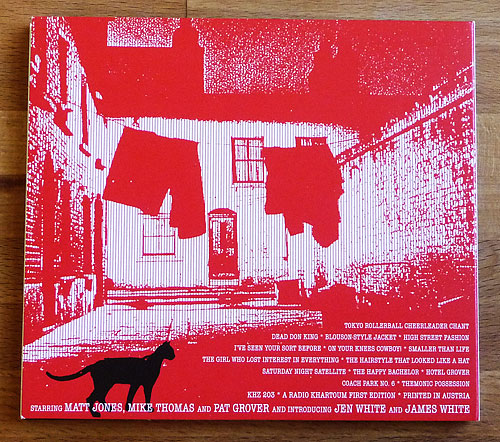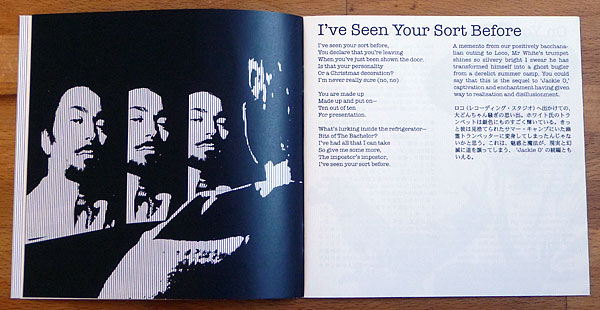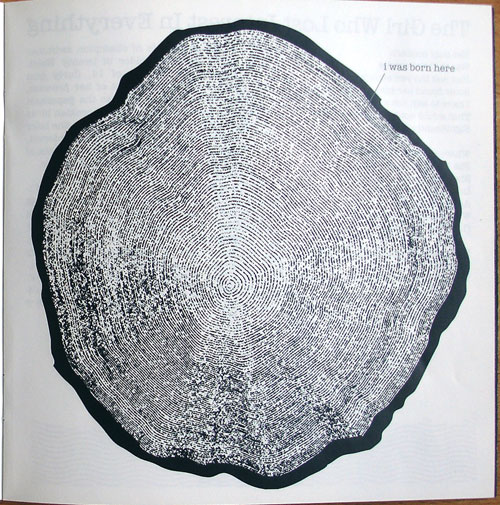The cover takes its cues from the album title (lifted, in turn, from a song which would not be recorded until the next album) and from something songwriter Matt Jones said to me in conversation to the effect of “all humor springs from the bad things in life.” Armed with this motto, we make a nod toward the “Beautiful Mover” (a boxer) of the previous record, and proceed to celebrate bad luck and misfortune.

Matt had originally requested a cover design with a dog (during the recording sessions the album had gone by the provisional title “First Dog”). A cat person myself, I reckon that having one’s path (in a dark alley) crossed by a black dog would truly be a bad omen!

And here begins the tradition of including a black cat on the inside leaf of Hepburns albums. Two and counting…
The discography here includes a couple of lost recordings. The master tapes for what would have been the band’s second album, Road Movie, disappeared with the guy who ran the short-lived Magic label. The BBC Wales session where “My Brother the Submariner” made its first recorded appearance would have made a marvelous 45. The sum that the BBC wanted for a license fee, however, seemed better spent on studio time for this album.

Drop out text at the center of the CD, always a nice touch.

Matt Jones got in the habit of sending over commentaries on his songs long before the songs themselves would arrive. This became the catalyst for the expanded lyric booklet. Lyrics. Prose commentaries on the songs. Illustrated commentaries on the songs and/or the commentaries.
Jun Kurihara (Nelories, Moonrace, Music Lovers, Raymonda…) provided the translations.
What follows are a few spreads from the 28 page booklet.

“You are made up
Made up and put on—
Ten out of ten
For presentation”

The Hairstyle That Looked Like a Hat is a spy theme masquerading as a wobbly waltz.
The handgun pictured here is the only photo in the package with traditional tonal range (i.e., neither maximum contrast nor oversize halftone pattern).

The Girl Who Lost Interest in Everything: This is the graphic which connects the album artwork to the 45 (which was supposed to come back from the factory at the same time, but that is another tale).
While virtually every other image on the album is rendered in high(est) contrast, generally overlaid with vertical hairlines, “The Girl Who Lost Interest in Everything” (a junior swim champion, according to Matt’s note) gets tonal variations on her legs, courtesy of an oversize halftone pattern. The diagonal lines of her legs meet the wavy lines of the water, and where the they overlap, the result is a moiré which makes sense.
Matt liked the diver’s legs so much he wanted this to be the cover of the album. Instead, it ended up being a poster for the album.
The Deciphering Linear A single, of course, takes the play with custom halftone patterns and figurative use of op art effects to technicolor levels.

Saturday Night Satelite: I saw Agnès Varda’s The Gleaners and I (Les glaneurs et la glaneuse, 2000) and thought the clock with no arms was perfect for the Hepburns. Apparently Javier Aramburu saw it too. I love his much more imaginative use of it in his cover for La Buena Vida’s Qué nos va a pasar.
Bügelfrei signature on the dial.

Smaller Than Life: “I could be a redwood, baby, reach to the sky; realistically speaking, more like a bansai.”
The best thing about this image is not that it was entirely computer generated, but that it is another clock with no arms.

The Happy Bachelor: While Matt’s note seeks to liberate “bachelor” from “pad,” this illustration supplied by German friends Jan & Tommy distills the architectural essentials from the song itself.

Themonic Posession: A cinematic conclusion to the album.





























